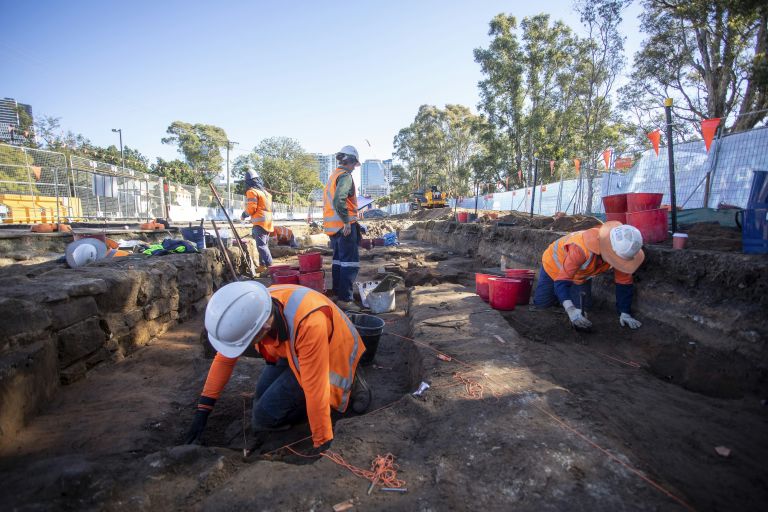Minimising impact
To minimise impact on heritage landmarks and items across the Greater Parramatta region, the Parramatta Light Rail project:
- has been designed to use existing road and rail corridors
- has measures in place to ensure that any found items are handled with care
- repurposes and pays respect to historical finds.
Transport is working with NSW Government departments and agencies including:
- Heritage NSW and NSW Health
- City of Parramatta Council
- local community organisations, including the Local Aboriginal Land Council and registered Aboriginal parties.
This is to ensure important heritage is preserved and maintained. The project teams have taken special care to avoid impacts on items of significance.
Greater Parramatta’s rich history
Archaeological investigations and heritage salvage works provide us with a unique opportunity to:
- learn more about the area’s history, both Aboriginal and non-Aboriginal
- preserve places and items of value.
The process
Archaeological salvage work is intended to assess and record any remains of historic sites, as well as potential Aboriginal sites, before construction begins. Archaeological investigations have been:
- conducted by excavating localised areas, or ‘sondages’
- excavated in linear trenches, or ‘test pits’ to determine the nature and extent of found archaeological material
- conducted layer by layer to assess the surrounding material until the bottom layer is identified.
What happens next?
Foundations or evidence of buildings are recorded and assessed by heritage specialists.
The project teams have consulted with Heritage NSW to discuss the best way to plan, respond and protect the items if impact can't be avoided.
Artefacts or heritage items identified during investigation works were labelled and documented in an excavation report by archaeologists. This ensures that any cultural materials unearthed are recorded and reported.
The project team has sought to protect and conserve found items. This includes:
- incorporating materials into public art or heritage displays around the light rail route
- sharing findings from our research.
Significant finds
When an archaeological find is unearthed, construction is halted until a decision is made about how to proceed.
Mitigation measures might include:
- a minor amendment to the design plans
- an alternate method of construction.
Where options have been exhausted, a detailed salvage excavation will take place involving:
- a controlled and systematic investigation
- recording and removal of archaeological deposits.
Early colonial or state-significant building materials found during salvage excavations are stored for potential reuse and interpretation.
Repurposing historical finds
In the course of building the new light rail network, historic finds are considered for heritage interpretation.
This means reusing or preserving the item for a specific purpose that will evoke and pay tribute to its history. The find is recorded before its removal.
For example, old sandstone can be reused in kerbing, footpath inlays and integration into landscape elements. These include borders or small walls.
In some instances, the project will share historic materials with local stakeholders such as:
- City of Parramatta Council
- Deerubbin Local Aboriginal Land Council.
Approximately 250 blocks of heritage sandstone were repurposed to recreate road kerbing along O’Connell Street in North Parramatta. This was part of the Parramatta Light Rail program of works.
